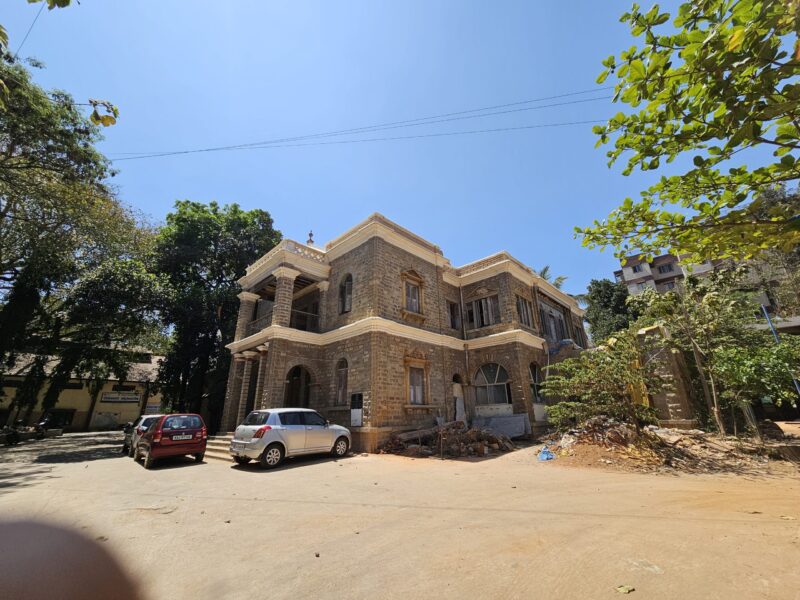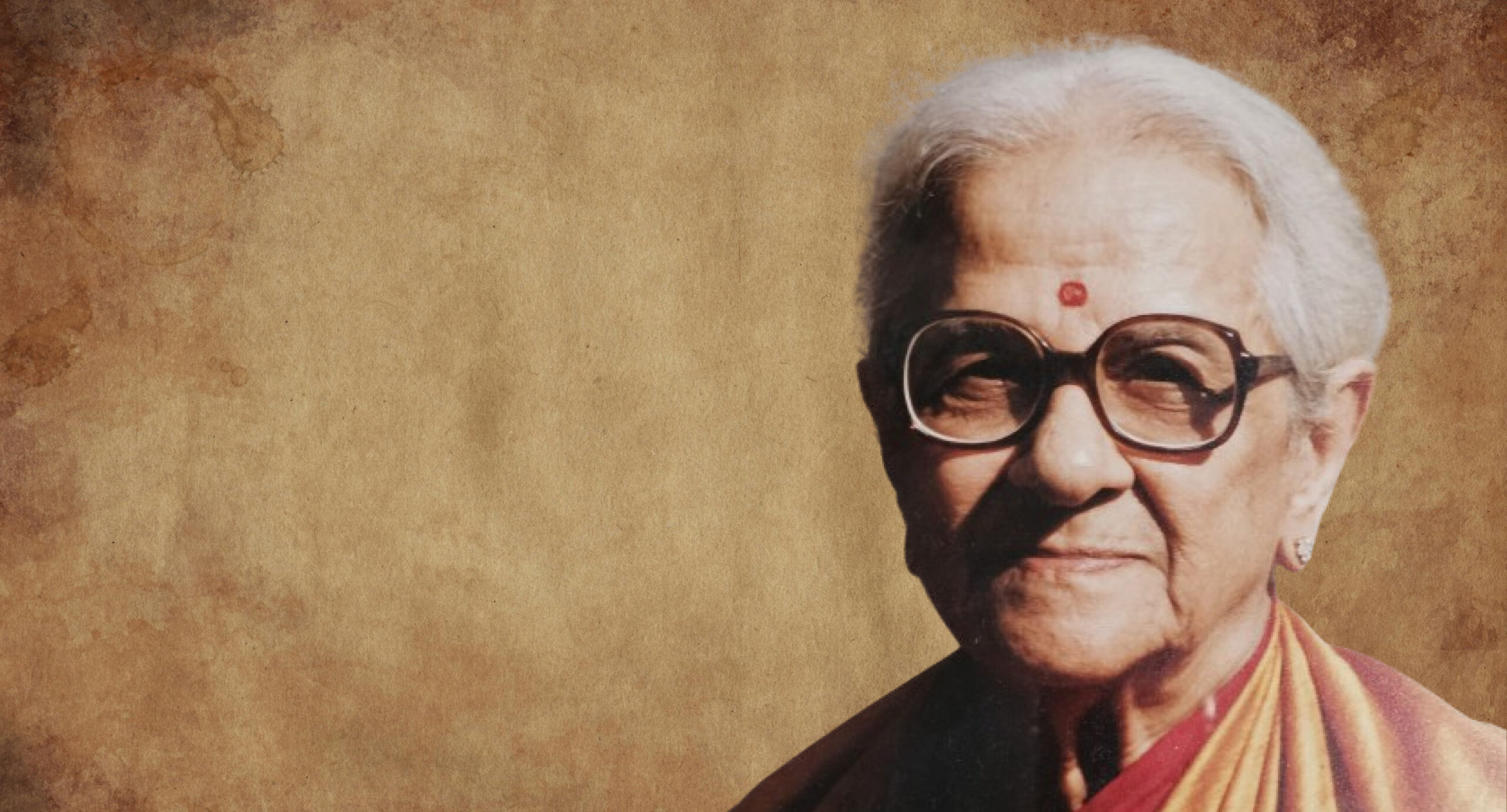H V Savitramma, granddaughter of H V Nanjundaiah, is one of the pioneers of women’s literature in Kannada. A quiet and unassuming person who stayed out of limelight, she strongly advocated for women’s rights through her books. Apart from her own short stories and novels, she translated several works of Tagore, Chekhov and Dickens into Kannada.
Text: Arvind Krishnaswamy
Family Background

H V Nanjundaiah’s house built in 1915 was donated to the Government Girls School in Malleswaram
Hebbalalu Velpanuru Savitramma was born in Bengaluru on May 2, 1913. She was fortunate to be part of an affluent family that attached a lot of importance to education. Her grandfather H V Nanjundaiah was an eminent academician, jurist and administrator. He was the first councillor in Krishnaraja Wodeyar’s cabinet. When Sir M Visveswaraya became Dewan, H V Nanjundiah was senior to him but was overlooked. Even though there was some heartburn about this, Sir M Visveswaraya treated Nanjundaiah with sensitivity and respect and both of them got along well. H V Nanjundaiah was a strong advocate of girls’ education and donated his home in Malleswaram to Government Girls School. There has been a long standing plan to renovate and rename it as H V Nanjundaiah Memorial School with part of the house planned to be a museum. H V Nanjundaiah also started Kannada Sahitya Parishat and was its first president for 5 years.
Childhood & Education

R K Narayan’s letter to H V Savitramma (Courtesy: V N Ramaswamy)
Savitramma greatly admired both her grandfather Nanjundaiah and her father Mysore Rama Rao who worked in the Mysore Palace as the palace controller. When she was just three years old, H V Nanjundaiah became the first vice chancellor of Mysore University. Just 7 years old when he passed away in 1920, she had only faint personal memories of him. However, she had the opportunity to learn more about him through his letters, documents and diaries when she wrote his biography in 1971. At a time when women did not generally have opportunities to study, she was encouraged to go to school. In some of the schools, she was the only girl in her class and had to endure taunts and mischief from boys.
Savitramma started her education at the London Mission School in Bengaluru but changed schools frequently as her father was periodically transferred to Hassan, Ramanagara and later to Mysore in 1925. At the age of 12, she completed her SSLC at Mission School in Mysore. In later years, when she went to Mysore, she proudly pointed out her school in Ramanagara on the way.
At the age of 13, she married her cousin H V Narayana Rao, aged 17. It is ironic that someone who wrote about women’s equality was a child bride herself. Around 1926, H V Narayana Rao graduated from Central College and went to London to study engineering. In those days, traveling to London took a month by ship and nobody returned until their education was completed. Hence Savitramma had about five years and she continued her education while staying with her parents. In 1931, Savitramma got her Bachelor’s Degree from Mysore University with three gold medals.
R K Narayan, who studied in Mysore University at the same time, was her neighbour in Laxmipuram. He wrote in his autobiography My Days that the pretty girl next door (without naming her) walked away with all the medals while he took a degree lost in the back row. Several years later, they met through R K Narayan’s cousin, became acquainted and kept in touch.
Personality

H V Savitramma in her youth (Courtesy: V N Ramaswamy)
Savitramma was the apple of her father’s eye and spent most of her time reading books or going for walks. She was a voracious reader and found comfort in books more than anything else. In her childhood she was quite a tomboy, climbing trees, riding bicycles with her younger brother, or learning to swim. She later remarked that having got used to this lifestyle, it was quite a shock when she had to take care of the house and cook for the entire family in her husband’s home. However, she learned not only how to cook efficiently but also supervised the work of the servants as well.
By nature, Savitramma was an introvert who talked less and kept to herself. At the same time, she was a disciplined person in all aspects of life including fiscal prudence. She was a light eater but she never missed her morning walk. She was very beautiful to look at in her younger days and the combination of beauty and brains did not go unnoticed during her college years.
Motherhood
Savitramma had five children and she was personally involved in their education. Between house work and taking care of them, she also managed to find time to write. During the 1950s, H V Narayana Rao was the Chief Engineer of hydroelectric projects in Mysore and he frequently travelled to Jog, Shivanasamudra and other places on work. Savitramma and the children stayed in Bengaluru so that their education was not disrupted. She independently ensured that all her children received good education and did well in life. As a mother she had a novel way of expressing her displeasure about something she did not like. She would resort to silence and stop talking. More often than not, this yielded the desired results and the offender would fall in line. She had a strong influence on all her children that lasted beyond her lifetime.
Writer

D V Gundappa’s autographed copy of Mankutimmana Kagga (Courtesy: V N Ramaswamy)
In her early years, Savitramma read very few Kannada books. She loved fiction and English literature, particularly the works of Dickens, Dumas and Gorky. During the 1950s, she developed an interest in Kannada literature influenced by T N Srikantaiah who was her teacher. Prof A N Murthy Rao who also taught her at Maharani’s College in Mysore was another source of inspiration for her. Even after her college days, she kept in touch and would often visit him at his Jayanagar residence. She also had the opportunity to meet Masti Venkatesha Iyengar and D V Gundappa regularly along with her husband Narayana Rao. As she started writing, they encouraged and praised her work.
Her first short story called Nirashrite (“refugee”) was published in 1949. Her initial stories were set against the canvas of independence and partition. Most of her short stories had women as main protagonists. A few examples that come to mind are Satyavati in the story “Adarsha” who follows Gandhi and devotes her life to the freedom struggle and rural service, Damayanti in “Damayanti” becomes a dedicated nurse after being abandoned by her husband and Kalyani in “Kalyani’” who bravely saves an old Muslim lady in communal riots.
Some of the women in her stories were British and American at a time when inter-racial marriages were few and far between. Across all her works, the common underlying theme was the individuality, independence and strength of the women in facing odds and charting their own future. Women in her stories and novels were years ahead of their time.
She wrote two novels based on Ramayana and her perspective was appreciated by feminist thinkers and activists. It was also controversial but showed that she had an independent mind of her own. On being asked why she wrote more short stories than novels, Savitramma laughed and said it was because she was lazy by nature and did not have the patience and perseverance to write a long book!

H V Savitramma’s translation of Dombey and Son by Charles Dickens (Courtesy: V N Ramaswamy)
Savitramma translated many books from English to Kannada. Eminent writers such as Shivarama Karanth, Masti Venkatesh Iyengar wrote forewords appreciating her efforts. Starting with Medieval India, a historical book written by Stanley Lane-Poole, she translated two books on Gandhi and three of Tagore into Kannada. When asked why she chose to be a translator, she remarked that there were always greater writers than oneself. Even though she translated works of mostly male writers, most of their books also had strong, modern women characters. Savitramma was fortunate to have the support of Mysore based Kavayalaya Publications, who published books by many famous Kannada writers for over 70 years.
Savitramma wrote for nearly five decades from 1949 to 1995, but for her writing was just a hobby. If she liked what she wrote, she would send it to magazines or have it published. She stayed out of the limelight and let her writing speak for her. She was the recipient of several awards of which the Soviet Land Nehru award, Kannada Sahitya Academy award and Kannada Women’s Writers Association’s Anupama award were notable. When she passed away at the age of 82 in 1995, Savitramma had just finished translating Dombey and Son, a novel by Charles Dickens but it remains unpublished.
Robert J. Zydenbos in The Calf became an orphan – the first doctoral dissertation about Kannada literature submitted at a university in the Western world – wrote, “Among the older generation of lady authors in Kannada, H V Savithramma did not receive the attention which was due from literary historians and critics, perhaps because her writing is not boisterous enough, although she has won a few literary awards. Her own creative writing (apart from her noteworthy translations from English into Kannada) is not very large in quantity, but has a remarkable thoughtfulness about it.”
In summary, her youngest son, V N Ramaswamy said, “Even aside from relationship bias, objectively looking she was an extraordinary person, very intelligent, kind hearted and never deviated from her principles. She never compromised and had a clear distinction between right and wrong. This led her to resent the gradual deterioration of public morals, ethics and the sorry state of politics. But, till the end she remained a private person who never sought publicity.”




